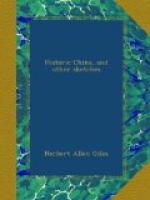One whole chapter is devoted to a division of the body into vital and non-vital parts. Of the former there are twenty-two altogether, sixteen before and six behind; of the latter fifty-six, thirty-six before and twenty behind. Every coroner provides himself with a form, drawn up according to these divisions, and on this he enters the various wounds he finds on the body at the inquest.
“Do not,” say the Instructions, “deterred by the smell of the corpse, sit at a distance, your view intercepted by the smoke of fumigation, letting the assistants call out the wounds and enter them on the form, perhaps to garble what is of importance and to give prominence to what is not.”
The instructions for the examination of the body from the head downwards are very explicit, and among them is one sentence by virtue of which a Chinese judge would have disposed of the Tichborne case without either hesitation or delay.
“Examine the cheeks to see whether they have been tattooed or not, or whether the marks have been obliterated. In the latter case, cut a slip of bamboo and tap the parts; the tattooing will then re-appear.”
In cases where the wounds are not distinctly visible, the following directions are given:—
“Spread a poultice of grain, and sprinkle some vinegar upon the corpse in the open air. Take a piece of new oiled silk, or a transparent oil-cloth umbrella, and hold it between the sun and the parts you want to examine. The wounds will then appear. If the day is dark or rainy, use live charcoal [instead of the sun]. Suppose there is no result, then spread over the parts pounded white prunes with more grains and vinegar, and examine closely. If the result is still imperfect, then take the flesh only of the prune, adding cayenne pepper, onions, salt, and grains, and mix it up into a cake. Make this very hot, and having first interposed a sheet of paper, lay it on the parts. The wound will then appear.”
Hot vinegar and grains are always used previous to an examination of the body to soften it and cause the wounds to appear more distinctly.
“But in winter, when the corpse is frozen hard, and no amount of grains and vinegar, however hot, or clothes piled up, however thick, will relax its rigidity, dig a hole in the ground of the length and breadth of the body and three feet in depth. Lay in it a quantity of fuel and make a roaring fire. Then dash over it vinegar, which will create dense volumes of steam, in the middle of which place the body with all its dressings right in the hole; cover it over with clothes and pour on more hot vinegar all over it. At a distance of two or three feet from the hole on either side of it light fires, and when you think the heat has thoroughly penetrated, take away the fire and remove the body for examination.”
It is always a great point with the coroner to secure as soon as possible the fatal weapon. If a long time has elapsed between the murder and the inquest, and no traces of blood are visible on the knife or sword which may have been used, “heat it red hot in a charcoal fire, and pour over it a quantity of first-rate vinegar. The stains of blood will at once appear.”




